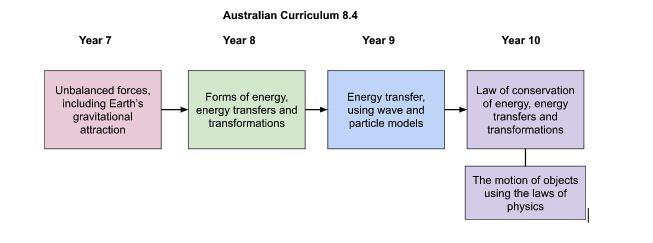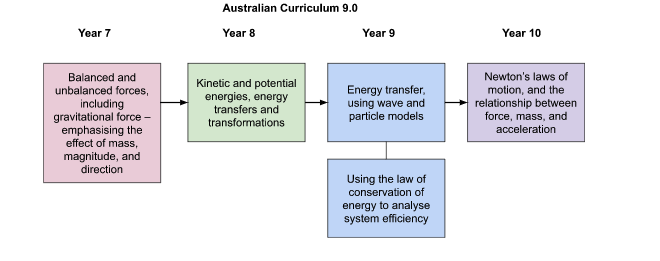
by Jacqui Bennett
Physics can be wonderful, giving students a deeper understanding of the how and why of the things they see. Unfortunately, it can also be daunting for some – with physics having a reputation for being complex. Luckily, the changes made to junior physics in the Australian Curriculum 9.0 are not too complicated. Let’s take a look.
This was the sequence of topics across Years 7-10 previously:

This is the sequence for Australian Curriculum v9.0:

In my opinion, Year 7 is meant to be light and fun. If we as teachers go too hard too early, students will quickly switch off from learning science. So it is a relief that the more hands-on balanced and unbalanced forces content is staying.
In Year 7 there is now more emphasis on the effect of changing the mass of an object, and the magnitude and direction of the forces. For example, magnitude of forces is mentioned when talking about Earth’s gravitational force, and simple machines now focus on how they result in a reduction in the magnitude of force required. There is also specific mention of using a force meter and representing magnitude and direction of forces using force diagrams. This has added clarity to the scope of the content, allowing teachers to explore key areas of this topic in depth rather than be overwhelmed by the multiple avenues that could be covered.
The gravity in space element of this topic has become less specific, moving from how gravity keeps planets in orbit around the Sun to how gravity ‘affects objects in space.’ This opens up a new avenue of exploration for students and gives teachers the flexibility to connect the concepts to space travel and other exciting space related ideas.
Year 8 has only minor changes, including the addition of electrical circuits to demonstrate electrical energy transfer as well as transformations into other forms of energy. This connects back to their work on electricity in Grade 6 and provides focus for real-world applications. The overall emphasis of the topic still appears to be on comparing kinetic and potential energies, and the relationship between them, which means resources from previous years can be used.
The most drastic change for physics in the new curriculum is moving the law of conservation of energy topic to Year 9 from Year 10. It’s difficult to teach the particulars of energy transfers and transformations without mentioning the law of conservation of energy, so this change will hopefully allow for a nice flow of information: where general concepts from Year 8 are built on directly after in Year 9.
Since energy transfer in an electrical circuit has been moved to Year 8, in Year 9 the topic is able to be more specific to the particle model and how it relates to static electricity and current. Wave and particle models also now specifically mention photons and electromagnetic radiation. The conservation of energy topic is similar to what it used to be in Year 10, but with the addition of elaborations on Sankey diagrams and the efficiency of power generation and appliances. There is also the addition of how improving efficiency in sporting activities results in improved performance – which could be a fun topic to explore for many students.
Year 10 is now solely about Newton’s laws of motion. This topic has always lent itself well to talking about driving, cycling, skating, and why we need safety equipment. Luckily, Australian Curriculum v9.0 continues this theme, containing elaborations on safety features in vehicles, school zone speed limits, and driverless vehicles.
Overall, the changes for v9.0 aren’t too complex, and you can maximise your energy efficiency by reusing resources from v8.4. The changes are balanced and there is potential for some great hands-on physics lessons that will increase student knowledge of the world to a higher magnitude.
Jacqui Bennett is the Science Content Associate at Edrolo.


